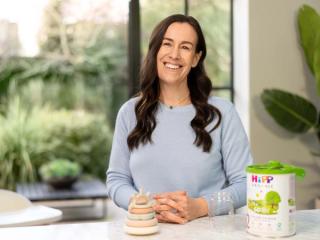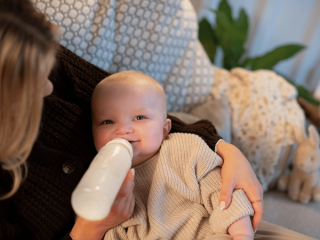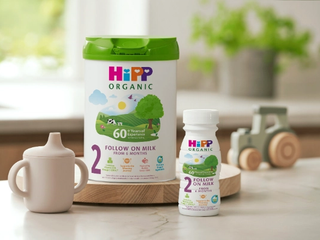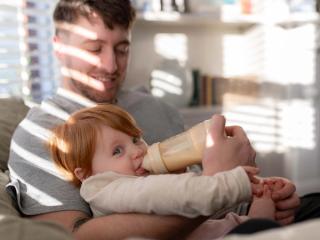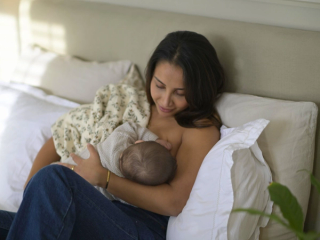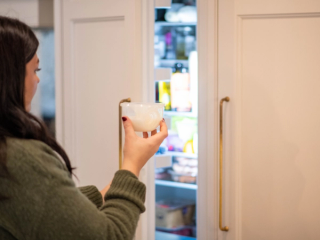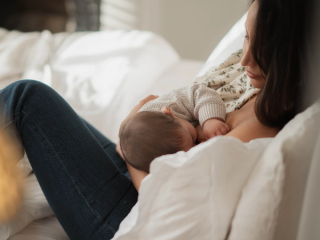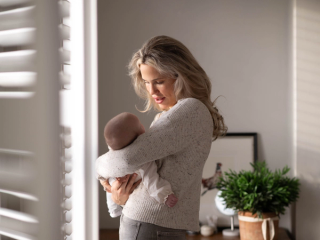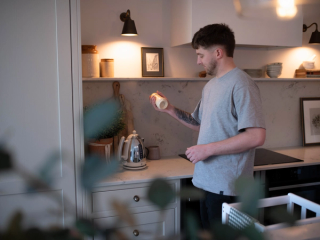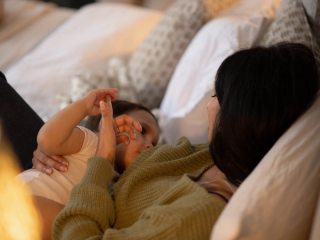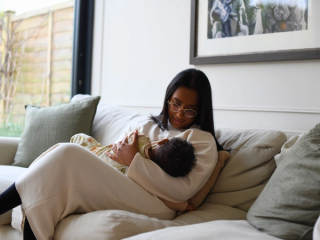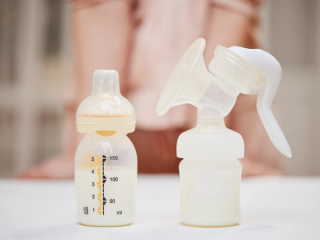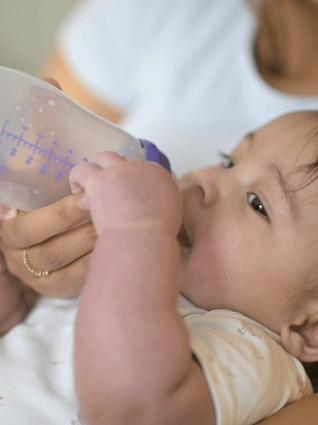
- Home
- Advice Hub
- Baby
- Baby Feeding
- Bottle Feeding Equipment
Things you'll need for bottle feeding
Read our detailed guide to find out what you need for bottle feeding, from choosing bottles & teats to sterlising safely, we have it all covered.
Feeding on demand, otherwise known as responsive feeding, is recommended by many health care professionals as best for babies – and for parents, since it keeps stress (and noise!) levels down. When you’re bottle feeding a newborn, being prepared makes all the difference. Having the right equipment ensures you’re ready to respond when your little one is hungry. To help, we’ve put together a simple guide to ‘how to bottle feed a baby’ and a kit list to take you from those early newborn days through every stage of your baby’s feeding journey.
Things you’ll need to bottle feed a baby:
- Bottles and teats with caps
- Brushes to clean out the bottles and teats
- Sterilising equipment
- Muslin or other burp cloth
- Milk (expressed breast milk, powdered formula, or ready to feed formula milk)
Finding the right bottle and teat for your baby
There are many different types of bottles and teats available. For a newborn, you might want to think about the size of the bottle – they drink little and often, so a smaller bottle might be easier. Teat flow rate is also important, as if milk flows too quickly from the bottle it can be hard for your baby to manage sucking, swallowing and breathing. Look for a teat that offers the right flow rate for your baby’s age.
It's also worth bearing in mind that some specialist milks are thicker and therefore need a different teat, so it’s important to refer to your health care professional and also the formula milk packaging for guidance.
Sterilising bottle-feeding equipment
It’s very important that any equipment you use for bottle feeding is thoroughly sterilised before each feed, to keep your baby safe. When babies are small and their immune systems are still developing, they're more vulnerable to illness, so it makes sense to protect them from germs when you can.
How often should you sterilise baby bottles?
You’ll need to sterilise all babies feeding equipment, including bottles and teats until your baby is at least 12 months old.
First, rinse out bottles, teats, caps, covers, breast pumps, etc. after each use and wash them thoroughly, using a bottle brush and hot soapy water. Then rinse again and sterilise.
Other bits, such as feeding beakers, bowls and spoons, don’t need to be sterilised for your baby if they’re 6 months or older; a thorough wash in hot, soapy water after each feed is enough to keep them clean.
Types of sterilisers
There are different methods for sterilising, and the one you choose really depends on what works best for you. Here are some of the options:
Steam sterilisers
These plug in and stand on the worktop. They heat small amounts of water into steam to kill bacteria. Follow the manufacturer's instructions for use, ensuring that the openings of bottles and teats are face down in the steriliser.
Microwave sterilisers
These work in the same way as steam sterilisers but are used in the microwave rather than being plugged in and are usually quicker than the steam kind.
Cold-water sterilisers
A special tablet is added to a measured amount of water in a plastic container, and the feeding equipment is submerged in the sterilising solution. Follow the manufacturer's instructions and make up a fresh solution every day. Ensure that all the equipment is properly submerged, with no trapped air, and is kept under the solution with a floating cover. Rinse bottles and teats with boiled water before use.
Away on holiday or visiting friends?
Microwave and steam sterilisers are quite bulky, so if you are away on holiday or visiting relatives or friends, you could just take a supply of cold-water sterilising tablets with you and a container large enough to sterilise a bottle or two.
You can also buy disposable sterilising bags, which are easy to use. You place the bottle, teat, etc. in the special bag, add a small amount of water, then seal and microwave. Often, the bag can be re-used several times (read the manufacturer's instructions), so these can be good for overnight trips.
Some companies even sell a disposable travel kit which has all the bottle-feeding equipment you'll need for two weeks in one small box (cleverly, the box doubles up as a cold sterilising unit for the teats and bottle caps).
Alternatively you can sterilise your feeding equipment by boiling it, making sure of course, that all the items you want to sterilise in this way are safe to boil!
Boil the feeding equipment in a large pan of water for at least 10 minutes, making sure it all stays under the surface.
Teats tend to get damaged faster with this method, so check that teats and bottles are not torn, cracked or damaged before feeding baby.
If you find yourself in a situation where you need to prepare formula feeds in advance there is important health and safety guidance to follow. as its always best to prepare formula fresh for each feed Ready to feed formula is a safer and easier option than preparing feeds in advance, or alternatively travel with a sterilised bottle, pre-measured powder and a vacuum flask containing freshly boiled water to make feeds up as you need them.
Please note that advice on preparing feeds when out of the home differs in Ireland. Refer to the HSE website for more information: Bottle feeds when you're away from home.
How to bottle feed a baby
Bottle feeding is an opportunity for you and others to bond with your baby, as you get to focus on them and get to know their cues. We have a complete guide to how to bottle feed your baby, but here’s a quick run-through of how it’s done.
Get comfy – some babies take a while!
Bottle feeding positions are not as varied as breastfeeding positions. Simply hold your baby horizontally against your body with their head resting on your arm so that they’re in a semi-upright position. You want to maintain eye contact with them as much as you can so you can give reassurance and talk to them while they’re feeding. This is important bonding time.
Hold the bottle horizontally
You’ll use your dominant hand to hold the bottle, so make sure baby’s head is on the correct side of your body. While you might picture the bottle being tipped right up, it actually only needs to be very slightly tipped – mostly horizontal – for your little one to suckle on the teat. Start by gently rubbing the teat against their top lip before inserting it in their mouth, always following their cues to make sure they’re happy.
Follow your baby’s cues
They may need several breaks while drinking, they may need burping mid-feed – you will get to know the signs that your little one is uncomfortable. Just as you are feeding on demand, you’re also stopping on demand. Newborn babies have little tummies, so it’s a case of little and often for the first several weeks.
Burp and cuddle
After a feed, always bring your baby into an upright position and pat or rub their back to help bring up any wind. It’s handy to have a muslin or similar handy in case this also brings up milk!
You don’t need to count the ml
Try not to get too hung up on how much milk your baby is drinking. They will let you know once they’re full and it’s important not to overwrite that natural instinct. You can tell they’ve had enough by how well they are growing and how many nappies they get through. If you have any concerns at all, speak to your healthcare professional.
If you’re formula feeding, you might also want to read our article on choosing and changing formula milks.
Bottle feeding FAQs
Every powdered formula milk will come with instructions about the correct ratio of powder to water, so make sure you refer to the packaging for manufacturers’ guidelines before mixing a feed.
Babies can be bottle fed from birth. Government recommendations are to introduce drinking from a cup or beaker from around 6 months to help prevent tooth decay.
Yes, as long as you are keeping all feeding equipment clean and sterilised and not leaving your baby alone with their bottle, bottle feeding is safe for a baby.
All babies are different, and some may adapt quickly to changes to formula feeds, whereas others may may need more time. If your baby is struggling with constipation, talk to your healthcare professional. Once your baby has begun weaning, remember they should also be drinking water and getting plenty of fibre in their diet. Check out our weaning guide for more information.
Conclusion
Bottle feeding comes with pros and cons. On the one hand, it’s much easier to share the load. On the other, there’s a lot more kit and clean-up. But once you get into the rhythm of preparing and sterilising bottles, it will soon become second nature.
Whether you are formula feeding, expressing, or combination feeding, take advantage of the lovely baby snuggles that go along with a feed, and the scrumptious milk-drunk smile that comes afterwards. If you have any concerns about your baby’s appetite or response to feeds, don’t hesitate to raise it with your healthcare professional. They would always rather hear from you than not and can advise on everything from reflux to flow rate and beyond.
Important Notice
We recognise that breastfeeding is best, providing many benefits to both mothers and infants. We also recognise that every parenting journey is unique, and we are here to support you through this journey, however you choose to feed your baby.
If you choose to breastfeed it is important that you eat a healthy well-balanced diet in preparation for and during breastfeeding. Before deciding to combination or formula feed your baby, note that reducing or stopping breastfeeding can be difficult to reverse. Babies feed on demand, so replacing breastfeeding with infant formula milk may reduce your supply. Formula feeding has both social and financial implications. Talk to your midwife or health visitor for guidance and support.
If you choose to use formula milk, make sure you choose the right milk for your baby’s age and prepare and store it according to the instructions on the packaging. Not doing so may make your baby ill. Infant formula is a nutritionally complete breastmilk substitute that can be used from birth. From 6 months you can choose to use follow on milk as part of a mixed diet and from 12 months you have the option to move onto growing up milk alongside a balanced diet.
